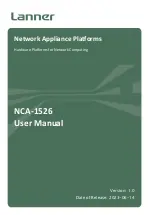
1-14
Cisco 10000 Series Router Software Configuration Guide
OL-2226-23
Chapter 1 Broadband Aggregation and Leased-Line Overview
Load Balancing Architecture Models
Per-packet load balancing allows data traffic to be evenly distributed in an IP network over multiple
equal-cost connections. Per-packet load balancing uses round-robin techniques to select the output path
without basing the choice on the packet content.
Single Ingress and Single Egress Provider Edge Applications
Figure 1-18
shows the provider edge 1 (PE1) router with three Interior Gateway Protocol (IGP) routes into
the core. Load balancing from customer edge 1 (CE1) to CE2 occurs on the PE1 router into different
paths. There is a single path for all destination prefixes on CE2 and a separate path for all destination
prefixes on CE4.
Figure 1-18
Single Ingress and Single Egress PE Load Balancing
For each destination prefix on a destination CE that requires unique Label Switched Path (LSP), selection
of the outgoing IGP path is in round-robin fashion. When there are multiple IGP paths from the ingress
PE to egress PE, the outgoing IGP path is chosen statically upon processing by the PXF. For different
destination prefixes, path selection is round-robin and each destination prefix has only one path. All
destination IP addresses mapping to the same destination prefix take the same path.
When there are multiple destination prefixes, load balancing occurs on traffic across the IGP paths. In
the case of only one or a few destination prefixes, load balancing does not occur on traffic across the IGP
paths and this behavior is the same whether load balancing is configured per-destination or per-packet.
Single Ingress and Two Egress Provider Edge Applications
Figure 1-19
shows the routing of packets from CE1 to CE2 using the PE1 router. There are multiple paths
for the destination prefixes on CE2. Load balancing occurs in the PXF of PE1.
P1
P2
PE1
CE4
CE2
PE2
158658
Dest prefix
10.1.1.1
20.1.1.1
Dest prefix
30.1.1.1
40.1.1.1
CE1
CE3
















































